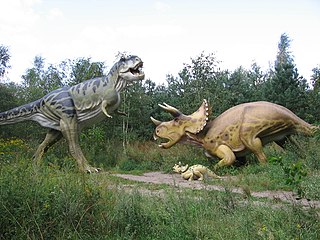 W
WCultural depictions of dinosaurs have been numerous since the word dinosaur was coined in 1842. The non-avian dinosaurs featured in books, films, television programs, artwork, and other media have been used for both education and entertainment. The depictions range from the realistic, as in the television documentaries of the 1990s and first decade of the 21st century, or the fantastic, as in the monster movies of the 1950s and 1960s.
 W
WEvo: The Last Gasp of the Dinosaurs is a German-style board game for three to five players, designed by Philippe Keyaerts and published by Eurogames. The game won the GAMES Magazine award for Game of the year 2002 and was nominated for the Origins Award for Best Graphic Presentation of a Board Game 2000. The game went out of print in 2007, and a second edition was released in 2011.
 W
WEvolution is a collection of short stories that work together to form an episodic science fiction novel by author Stephen Baxter. It follows 565 million years of human evolution, from shrewlike mammals 65 million years in the past to the ultimate fate of humanity 500 million years in the future.
 W
W"A Gun for Dinosaur" is a time travel science fiction story by American writer L. Sprague de Camp as part of his Rivers of Time series. It tells the story of four men who travel into the past to hunt dinosaurs.
 W
WJurassic Park, later also referred to as Jurassic World, is an American science fiction media franchise centered on a disastrous attempt to create a theme park of cloned dinosaurs. It began in 1990 when Universal Pictures and Amblin Entertainment bought the rights to the novel by Michael Crichton before it was published. The book was successful, as was Steven Spielberg's 1993 film adaptation. The film received a theatrical 3D re-release in 2013, and was selected in 2018 for preservation in the United States National Film Registry by the Library of Congress as being "culturally, historically, or aesthetically significant".
 W
WRivers of Time is a 1993 collection of science fiction short stories by American writer L. Sprague de Camp, first published in paperback by Baen Books. All but two of the pieces were originally published between 1956 and 1993 in the magazines Galaxy, The Magazine of Fantasy & Science Fiction, Analog, and Asimov's Science Fiction, and the Robert Silverberg-edited anthology The Ultimate Dinosaur. The remaining pieces were first published in the present work.
 W
WSpeedy in Oz (1934) is the twenty-eighth in the series of Oz books created by L. Frank Baum and his successors, and the fourteenth written by Ruth Plumly Thompson. It was Illustrated by John R. Neill.
 W
WStegosaurus is one of the most recognizable types among cultural depictions of dinosaurs. It has been depicted on film, in cartoons, comics, as children's toys, as sculpture, and even was declared the state dinosaur of Colorado in 1982. Stegosaurus is a subject for inclusion in dinosaur toy and scale model lines, such as the Carnegie Collection.
 W
WThe "raptors" portrayed in Jurassic Park were actually modeled after the closely related dromaeosaurid Deinonychus. Paleontologists in both the novel and film excavate a skeleton in Montana, far from the central Asian range of Velociraptor but characteristic of the Deinonychus range. A character in Crichton's novel also states that "Deinonychus is now considered one of the velociraptors", which suggests that Crichton used the controversial taxonomy proposed by Gregory S. Paul, even though the "raptors" in the novel are at another point referred to as V. mongoliensis. Crichton met with the discoverer of Deinonychus, John Ostrom, several times at Yale University to discuss details of the animal's possible range of behaviors and appearance. Crichton at one point apologetically told Ostrom that he had decided to use the name Velociraptor in place of Deinonychus because the former name was "more dramatic". According to Ostrom, Crichton stated that the Velociraptor of the novel was based on Deinonychus in almost every detail, and that only the name had been changed. The Jurassic Park filmmakers also requested all of Ostrom's published papers on Deinonychus during production. They portrayed the animals with the size, proportions, and snout shape of Deinonychus rather than Velociraptor.